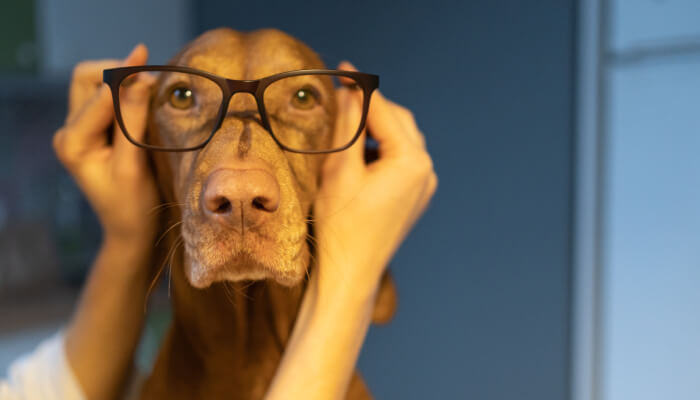Most people consider caring for Vizsla as an easy task until they come across their health issues. Unfortunately, ear infections are among the most common health problems in Vizslas. It is because of their floppy ears which trap dirt and moisture. This post will talk about the causes, treatments, and prevention of ear problems in Vizslas.
Ear infections in Vizslas can happen due to the inflammation of the eustachian tube or infections of bacteria or yeast. One of the most common causes of an ear infection in dogs is from swimming in polluted water. Besides this, they can also develop an ear infection due to allergies, skin conditions, and even hormonal imbalances.
These dogs are prone to developing ear infections in the early stages of their lives when Vizslas start teething and chewing on anything available in their reach. So to prevent ear problems in Vizslas, provide them with a comfortable place where they can rest and avoid chewing on random available items.
Are Vizslas Prone To Ear Infections?
Yes, Vizslas are prone to ear infections. The Vizsla has a strong hunting instinct which makes them prone to ear infections. In addition, their floppy ears have an opening that can easily clog debris such as dirt or hay. It is the most common cause of ear infections in this breed of dog. If left untreated, their infection will spread further into their head and neck.
What Is Ear Infection In Vizsla?
Ear infection in Vizslas usually causes inflammation and pain inside their ear canal, leading to more severe problems if not treated early. They result due to bacteria that thrive when the dog’s ear canal is moist and warm. A bacterial infection in the ears can also cause a low-grade fever, redness around the head, scratching at their ears, or excessive wax coming out of them. Therefore, it should alert you that they are running an ear infection.
The most common types of infections Vizslas get are yeast or fungal infections. These infections may result from a fungus that thrives in warm, wet, and humid environments such as the ear canal of dogs. One way to tell if your dog has this type of infection is to have excessive discharge coming out from their ears or smells terrible inside them. However, all these could also be an indication of bacterial or viral infections as well. For example, yeast infections have a thick discharge that is usually white or yellow.
Causes Of Ear Infections In Vizslas
The breeds with floppy ears are most prone, but any species can contract this issue with a strong hunting instinct.
All of these factors, I have listed below, can contribute to an ear infection in your dog.
Dirt Or Hay In The Ear
If you have a Vizsla, they are prone to ear infections. It happens because the dog has floppy ears that can quickly get dirt or hay in them. If the soil or grass stays there for a long time, it will cause an infection and spread to their head and neck.
Hair Wrapped Around The Ears And Head
If your dog has long hair and you are not grooming it regularly, they can wrap their hair around the ears and head. Usually, this will clog any ear holes that may be there, leading to an infection in the future.
Excess Ear Wax
Ear wax is often a sign of allergies or inflammation inside of the ear canal. The excess ear wax may be due to allergies or bacteria buildup inside the dog’s ears.
Insect Bites Near Ears
If your dog has floppy ears, they are more prone to insect bites near their ears. Moreover, this is because the opening of the ear canal and exterior skin around it is very vulnerable to bug bites. Thus, it can lead them to get an infection in the future.
Pinched Nerves In Neck
If your dog has a pinched nerve in their neck, it will be difficult for them to shake their head and ears, leading to ear infections because they are more likely not to clean the dirt or hay out of those areas.
Scar Tissue On Inner Surface Of Ears
If your dog has a scar on the inside of its ear, it could lead to an infection. Usually, bacterias quickly settle in those ears leading to the ear infections of Vizslas.
Water Trapped Inside The Ears
The trapping of water in the ears is a widespread problem for dogs. If the dog swims in water or gets their head damp, they are more likely to have an ear infection. Usually, there will be excess moisture and more room for trapping the bacterias inside their ears. Thus, this can lead to an infection in the future.
Signs That Show Your Vizsla Has Ear Infections
There are a few common signs that show your Vizsla has an ear infection.
- Your Vizsla may be shaking their head more than usual, which could indicate they have an ear problem.
- You can also see dark brown wax coming out of the ears.
- One side of the face is redder and inflamed than the other side. It indicates your dog has an ear infection.
Treatments Of Ear Problems In Vizslas
If you notice early signs that may indicate an ear infection, you should take them to the vet as soon as possible. Your dog will need a thorough examination and treatment for their ear problem.
There are also some treatments that you can use at home to treat your dog’s ear problems before they get worse. The three most popular methods of treating this issue are warm compresses, topical ointments, or oral medications.
Warm Compresses
You can use a warm cloth to put on your dog’s ears that will help reduce the inflammation in their ear.
Topical Ointments
There are some topical ointments you can purchase at any pet store, such as Pyoben. This medication contains antibiotic and steroid combinations. You must apply this cream directly onto the dog’s ear multiple times a day.
Oral Medications
If the dog has an infection still spreading despite treatments, your vet may prescribe oral antibiotics to help clear up their problem.
Prevention Of Ear Infections In Vizslas
There are a few methods that you can do to prevent your dog from getting an ear infection in the future. These include:
Cleaning Ears Regularly
Dog parents should be cleaning their Vizslas’ ears regularly with a damp cotton ball or cloth. The owners must wipe the ears of their pets gently until removing all debris from the ear.
Regular Baths And Shampooing
Bathing your dog regularly and shampooing them will help keep their skin healthy and the hair around their ears. It would help if you cleaned your dog at least once or twice a week. After that, you can increase the frequency and bathe them more often. But do not leave your Vizsla sticky for more than a month.
Grooming
Groom their hair regularly so they don’t wrap it around their head or ears and cause an infection.
Clean Their Head And Ears
Keep their ears and head clean to prevent dirt or hay from getting in the ear, which can lead to an infection.
Trim Their Nails
Trim your dog’s nails, so they don’t scratch at their ears. Frequent scratching and itching can cause injures and bacterial infections in the ear of Vizslas.
Say No To Swimming With Vizsla
Do not swim with your Vizsla because this could cause water trapped inside the ears, leading to an infection.
Keep Them Safe From Bugs
Don’t let your Vizsla get insect bites near their ears. It will increase the chances of getting an ear infection because they are more likely not to clean off dirt or hay in that area.
No Outing In Rain
Avoid letting your dog go out when there is a lot of rain and moisture outside because this can lead to an ear infection.
No To Long Floppy Ears
Do not let your Vizsla get along, floppy ears because they are more likely to have an ear problem in the future.
Can Ear Infections In Vizslas Make Them Deaf?
If left untreated or neglected for too long, an infected dog’s ear could make them deaf. If you notice your dog shaking Vizlsas head a lot, scratching at their ears, or having excessive wax coming out of the ear, then it is time to take them in for treatment.
How Can I Treat My Dogs’ Ear Infection At Home?
If your dog has an ear infection and needs treatment at home, the best thing you can do is get some topical ointment to put on their ears. You should also provide some hot water in a bowl or pot so that they can dip their head into it for 15-20 minutes. While they’re doing this, make
A guideline to follow to prevent ear infections in Vizslas are by:
- Giving a bath at least once or twice a week
- Clipping their nails regularly
- Brushing off dirt from the outside of their ears with regularity.
- Always check the ears of your Vizsla and clean them weekly.
If you notice anything out of the ordinary with your dog’s ears, it is best to take them to a vet as soon as possible.
Conclusion
In a nutshell, ear infections may occur due to bacteria, fungi, or yeast. It can be an irritating problem for dogs of any age and breed but is more common in long-haired breeds like the Vizsla.
Overall, there are ways to prevent your dog from having ear problems. However, if you notice any symptoms, it is best to check with a vet as soon as possible.
We hope that this blog post was helpful! Please feel free to comment below with any questions or concerns.



